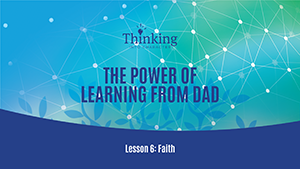Lesson 6: Faith
Lesson 6 – Faith – Part 1
In this video, we introduce the concept of faith. The faith that we are talking about here is not religious faith, but rather a firm conviction in a positive future outcome. We have said previously:
“Faith, is the ability to see the invisible and believe in the incredible and that is what enables believers to receive what the masses think is impossible” – Clarence Smithison
As well as introducing the concept of faith, and its relationship to love and affection, we look here at how faith may be induced or created by affirmation or repeated instructions.
Faith in a new idea can be developed if it is frequently repeated and emotionalised. In fact, the mind generally takes to be true any idea that is presented to it with enough frequency and emotional intensity. This is the principle of autosuggestion described by Napoleon Hill and you can see the same phenomena inappropriately used in propaganda. The mind is indeed a fertile ground, it bears fruit to the ideas and practices routinely placed there and sufficiently emotionalised, be they good or bad.
We can see the power of faith exemplified in two key events, which are discussed in the video. These are:
- the popular rise of Mahatma Gandhi
- the popular response to the great depression
Additionally, in this video predictions for the future of work and industry are discussed. Specifically, it is suggested that:
- There will be labour transformation due to increased mechanisation
- Leaders will need to be retrained to enable them to have even greater emotional intelligence .
- The principle of faith and being able to mobilise faith in others will become an increasingly useful skill
- There will be more faith and cooperation mobilised as a response to fear
Lesson 6 – Faith – Part 2
There is a deeper science of nature that is not taught in schools. This is the idea that nature is a mass of energy, made up of constructive and destructive vibrations. These vibrations act as responses to the positive or negative vibrations of individual thoughts. This is the premise behind the law of vibration and the law of attraction made recently popular through the work of Bob Proctor.
The attitude of faith is a vibration. It signals confidence about the future, an expectation that good times will materialise. By means of the law of attraction, nature responds to the attitude of faith by providing opportunities and experiences that reconfirm our original attitude. This is why, very generally, having a positive mental attitude is so critical for success.
As Walter D. Wintle points out in his famous poem summarised here: If you think you are beaten, you’ve lost the game. If you think your outclassed the same. For lives battles do not always go to the stronger or faster person, sooner or later the person who wins is the person who thinks they can.
How do we get to know and understand the effect of faith and the law of attraction more generally? Here it is crucial to study yourself, your attitudes and your results. Subsequent videos will elaborate on these points.
The final point to consider about the concept of faith as it is introduced here is the relationship between faith and wellbeing. The attitude of faith is expressed as wellbeing, a feeling of being confident and at ease. The opposite of faith is fear. Fear is expressed through the body as dis-ease, a feeling of anxiety and distress. Thus cultivating the attitude of faith is as important as cultivating the attitude of gratitude, previously discussed. These two positive attitudes have great effects. Both lead feelings of ease, contentment and wellbeing. It is in this space that we can be creative and produce our best work
“Faith and fear both demand you believe in something you cannot see. You choose!”

